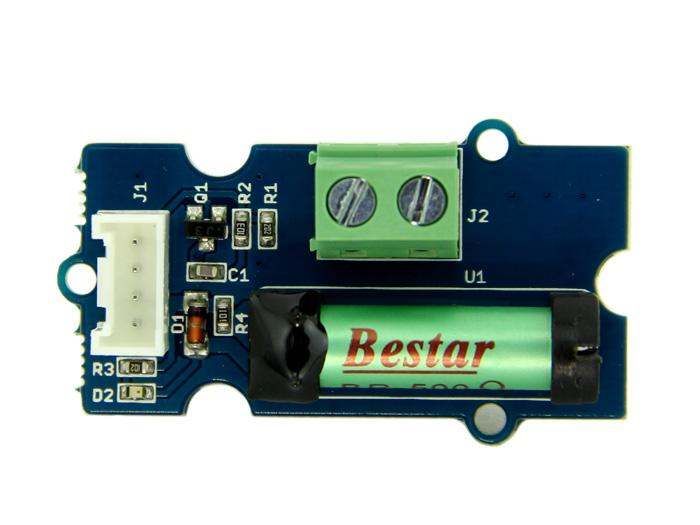Grove - Dry-Reed Relay
Introduction

The Grove-Dry Reed Relay is a relay module which works through magnetizing the vibration reed via the current in the coils. Compared to electromagnetic relays, the contacts completely sealed is the biggest feature of the Dry-Reed Relay. Besides, it features simplicity in construct, compactness, fast speed and long life, which make it widely applied in many fields such as microelectronic detection, Automatic Control etc.
Features
- Grove Interface
- High Speed
- Good stability
- Long contact life
- Contact fully sealed
Tip
More details about Grove modules please refer to Grove System
Specifications
| Item | Min | Typical | Max | Unit |
|---|---|---|---|---|
| Voltage | 4.8 | 5.0 | 5.2 | VDC |
| Coil Resistance | 225 | 250 | 275 | Ω |
| Pick-Up Voltage | 3.75 | VDC | ||
| Switching Current(Max) | 0.5 | A | ||
| Switching Voltage(Max) | 120 VAC/60VDC | - | ||
| Carrying Current(Max) | 1.0 | A | ||
| Operate Time(Max) | 1.0 | mS | ||
| Release Time(Max) | 0.5 | mS | ||
| Mechanical Life(at no load) | 1×108 operations | - | ||
| Ambient Temperature | -30 | / | 70 | ˚C |
Platforms Supported
Usage
With Arduino
The Dry-Reed Relay can support up to 60VDC 1A load. You can use it to control resistance load, but it is not applicable to inductive load(such as Motor).
The usage of this Dry-reed relay is quite alike that of common relays.
- Connect electric light to Grove - Dry-Reed Relay and power for electric light.
-
Connect Grove - Dry-Reed Relay to port D2 of Grove - Base Shield and plug it into Arduino/Seeeduino.
-
Upload the below code.
int Relay = 2;
// the setup routine runs once when you press reset:
void setup() {
// initialize the digital pin as an output.
pinMode(Relay, OUTPUT);
}
// the loop routine runs over and over again forever:
void loop() {
digitalWrite(Relay, HIGH); //the Relay close(HIGH is the voltage level)
delay(5000); // wait for five seconds
digitalWrite(Relay, LOW); //the Relay normally open by making the voltage LOW
delay(5000); // wait for five seconds
}
- The electric light will light up for seconds ,then off for seconds, repeatedly.For the special applications, you may need to write the code by yourself.
With Raspberry Pi
1.You should have got a raspberry pi and a grovepi or grovepi+.
2.You should have completed configuring the development enviroment, otherwise follow here.
3.Connection
- Plug the sensor to grovepi socket D4 by using a grove cable.
4.Navigate to the demos’ directory:
cd yourpath/GrovePi/Software/Python/
- To see the code
nano grove_relay.py # "Ctrl+x" to exit #
import time
import grovepi
# Connect the Grove Relay to digital port D4
# SIG,NC,VCC,GND
relay = 4
grovepi.pinMode(relay,"OUTPUT")
while True:
try:
# switch on for 5 seconds
grovepi.digitalWrite(relay,1)
print "on"
time.sleep(5)
# switch off for 5 seconds
grovepi.digitalWrite(relay,0)
print "off"
time.sleep(5)
except KeyboardInterrupt:
grovepi.digitalWrite(relay,0)
break
except IOError:
print "Error"
5.Run the demo.
sudo python grove_relay.py
Resources
| Arduino | Wio | BeagleBone | Raspberry Pi | LinkIt ONE |
|---|---|---|---|---|
 |
 |
 |
 |
 |
Caution
The platforms mentioned above as supported is/are an indication of the module's hardware or theoritical compatibility. We only provide software library or code examples for Arduino platform in most cases. It is not possible to provide software library / demo code for all possible MCU platforms. Hence, users have to write their own software library.
Help us make it better
Welcome to the new documentation system of Seeed Studio. We have made a lot of progress comparing to the old wiki system and will continue to improve it to make it more user friendly and helpful. The improvement can't be done without your kindly feedback. If you have any suggestions or findings, you are most welcome to submit the amended version as our contributor via Github or give us suggestions in the survey below, it would be more appreciated if you could leave your email so that we can reply to you. Happy Hacking!

